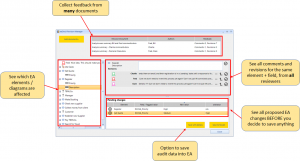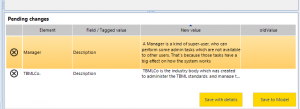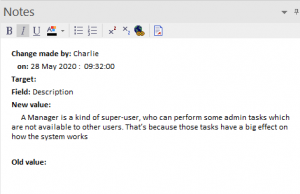Home / eaDocX Homepage / EaDocX Help / Revision Manager / Introduction to Revision Manager
Introduction to Revision Manager
eaDocX Revision Manager lets you generate documents which your readers can interact with: “Interactive Documents“.
With Interactive Documents, you can take the revisions and comments which your readers make, combine them together in a single view, then quickly copy changes to the exact EA element and field which they refer to. And see where there are issues which you need to think about some more.
Creating an Interactive Document
In the eaDocX generator, under the ‘Generate’ option, choose ‘Interactive’. If you have Revision Manager installed, then this will generate a document. It adds invisible text tags to your Word document. Provided readers don’t switch-on Word invisible text, they should not be aware of any difference between an Interactive Document and a regular eaDocX document.
Using an Interactive Document
Your readers can then review and comment on your document in whatever way they are used to:
- each reader has their own copy of your document,
- multiple users can collaborate on a single copy, using, for example, Microsoft Teams.
- you can use the document yourself to proof-read the final document
All readers MUST use Word ‘Track Changes’. When the document is genreated eaDocX Revision Manager will put the Word document into ‘Revision’ mode, and switch on ‘Track Changes’, but a user may switch this off. In this case, their changes cannot be processed using
Revision Manager
When you have one or more Interactive Document, you can view all the documents in Revision Manager:

Revision Manager parses the Interactive Documents, and presents the you with a combined view of who has made which changes.
Processing Revisions
To process all the changes in all the documents:
Step through the revisions. You can either:
1 – Accept a revision from a user:

This copies the text ‘Medium’ which Fred wrote into the ‘Priority’ of the ‘Get Quote’ use case, and adds it to the Pending changes.
2- Copy Fred’s change into the ‘Get Quote’ priority:

You can then edit the new value, and save it to the pending changes:

3 – Skip the revision, and select the next EA element, diagram or package, and look at the comments and revisions
Processing Comments
Some comments can be associated with a specific EA element. diagram or package. Some cannot. Also, some revisions cannot be associated with a specific EA element field. These are both shown like this:

Here, Ian has added a comment or revision to the ‘Use Cases’Â package, but we can’t work out exactly which field of the EA package he has changed.

Here. Fred has made a comment which we can’t associate with any EA content, so the comment is shown in the position in the source document where the comment was made.
Reviewing the pending changes
As you accept each change, it gets added to the list of Pending Changes. This allows you to review all the changes together, in case they conflict with each other:

Making changes in EA
You can remove any changes from the Pending Changes list, then either:
- Save to model. This will make changes to the EA model directly. Changes are made under the name of the current EA users
- Save with Details. Saves to EA, and also adds some audit-trail information, in the form of a new EA element:
![]()
The notes field of this element, which is a child of the element which was updated, will look like:

Because this is a normal EA Element, you can now include it in future versions of the document. This is best done by creating an Element Report with all the elements of this type, and a hyperlink in the source element.